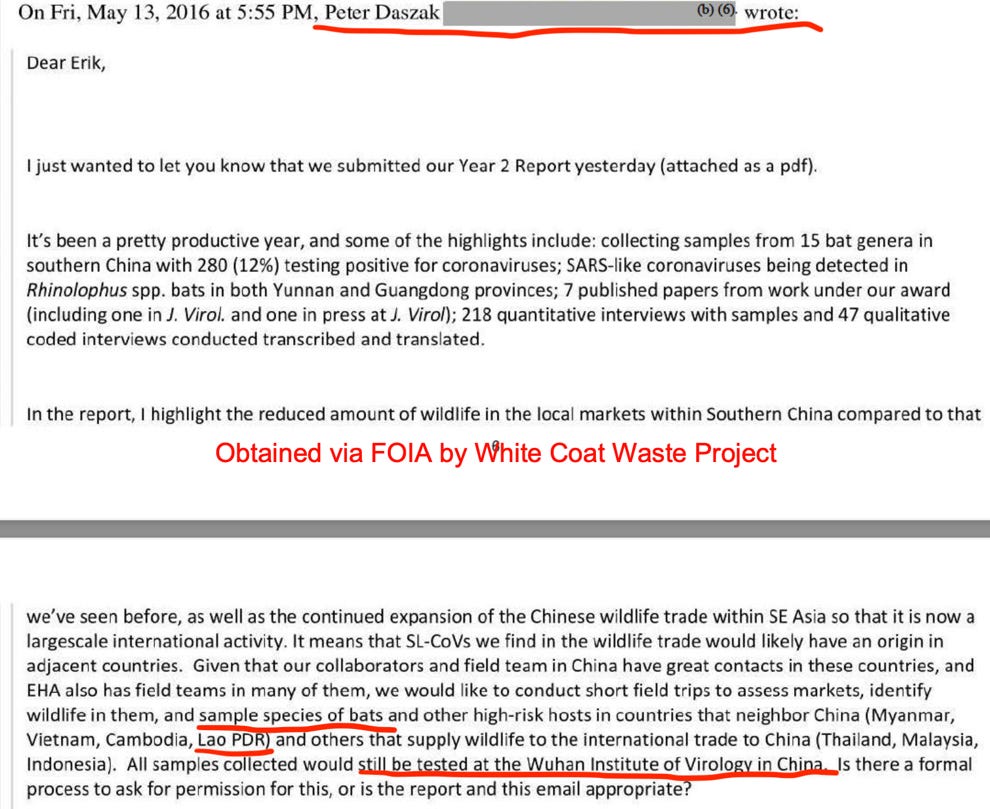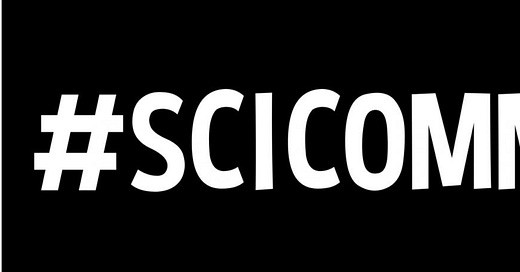Documents from the National Institutes of Health Call into Question Articles by Science Writers at Nature, Science, and the New York Times
Pre-prints bolstering claims the COVID-19 pandemic did not start in a Wuhan lab are a science writer’s favorite meal.
6 minute read
Okay. Here we go again. Another scicomm fail.
In the last month, science writers at Nature, Science, and the New York Times wrote articles arguing that viruses found in Laos—and closely related to the SARS-CoV-2 virus—added further evidence that the COVID-19 pandemic could not have started from a lab leak in Wuhan, China. Unfortunately, a batch of documents released earlier this month point to the Wuhan Institute of Virology as a possible source of these viruses found in Laos. According to those e-mails, researchers with the nonprofit EcoHealth Alliance apparently were collecting viruses in Laos since around 2016 and shipping them to…the Wuhan Institute of Virology.
One would think these e-mails would send science writers scrambling to contact their friends at the EcoHealth Alliance to figure out what happened. But, no.
Since the pandemic’s beginning, science writers have been committed to undermining any evidence that points to research by Shi Zhengli of the Wuhan Institute of Virology as the possible source of the pandemic. So of course, these e-mails must be ignored.
Here’s what happened.
In late September 2021, a group of French researchers posted a pre-print that discussed finding SARS-CoV-2-like viruses in bats captured in Laos. Furthermore, the viruses found in Laos are very similar to the SARS-CoV-2 virus that started the current pandemic.
Pre-prints are papers that are not peer reviewed but are an easy snack for science writers whose reporting diets mostly consist of press releases from science journals and quotes from favored scientists. And a pre-print that found viruses closely related to the COVID-19 virus, but that originated really far away from the Wuhan Institute of Virology, became a feast for science writers who have been doing their best to downplay the possibility of a lab leak in Wuhan as the pandemic’s cause.
First to grab a fork and knife and dig into this appetizing pre-print: Nature Magazine science writer, Smriti Mallapaty:
The story’s headline telegraphed to readers the same leaden messaging we have seen many times from Nature, ever since the pandemic started and editorial staff began attacking any idea that the pandemic could have originated from a Wuhan lab accident. The article reinforced this narrative in the second sentence:
Researchers say that parts of their genetic code bolster claims that the virus behind COVID-19 has a natural origin — but their discovery also raises fears that there are numerous coronaviruses with the potential to infect people.
Basically, we aren’t told how the genetic code of the Laos viruses bolster claims COVID-19 has a natural origin, but a bunch of researchers said so to Nature, and when scientists say something, we’re all supposed to down it like shots at a college house party—because science. The article continued:
The study also doesn’t clarify how a progenitor of the virus could have travelled to Wuhan, in central China, where the first known cases of COVID-19 were identified — or whether the virus hitched a ride on an intermediate animal.
Answers might come from sampling more bats and other wildlife in southeast Asia, which many groups are doing.
Answers might also come from considering the obvious, like someone might have shipped the virus to the Wuhan Institute of Virology which has been collecting viruses for many years. But that would require reporters at Nature to dig through some e-mails and make some embarrassing calls to their friends in virology and at the National Institutes of Health.
Second up for a tasty pre-print dinner: Jon Cohen of Science Magazine:
Note how the article’s subhead emphasizes that a supposed key feature of the COVID-19 virus is that it “exists in the wild” implying it couldn’t be found in a lab. One could be forgiven for thinking ‘Definitely not a Wuhan lab!’ if your main source of information is Science Magazine.
Cohen’s article is a bit more balanced than that of Nature’s Mallapaty, and it offers up a dog’s breakfast of differing views to wade through, if you have the time. If you really care.
In one example, Cohen quotes Duke University researcher Linfa Wang stating, “The core, functional part of SARS-CoV-2 has a natural origin. It’s proven.” (As is common in journalism practiced at Science Magazine, readers are not told that Linfa Wang is a co-investigator on EcoHealth Alliance’s grant with Shi Zhengli of the Wuhan Institute of Virology.)
Finally, there’s Carl Zimmer, the New York Times’ wooly-headed science writer. In 2020, Zimmer wrote a tribute to Wuhan’s Shi Zhengli and attempted to put a stake through any thought that the pandemic could have started from an accident in her lab.
“The charge is not just baseless but dangerous,” Zimmer wrote, praising the Wuhan researcher.
Three months later, the U.S. State Department released a fact sheet on the Wuhan Institute of Virology that found the institute conducts “gain-of-function” research to engineer chimeric viruses and collaborates on secret projects with China’s military. This June, NBC News confirmed Shi Zhengli’s ties to the Chinese military.
Why in the world the New York Times allows Zimmer to continue reporting on the pandemic’s origin is unclear. But with such commitment to Shi Zhengli, it seems obvious why Zimmer devoured a pre-print that argued the closest related viruses to COVID-19 are found in a Laotian bat cave far, far away from Wuhan. Here is how Zimmer played up the findings:
Virus experts are buzzing about the discovery. Some suspect that these SARS-CoV-2-like viruses may already be infecting people from time to time, causing only mild and limited outbreaks. But under the right circumstances, the pathogens could give rise to a Covid-19-like pandemic, they say.
The findings also have significant implications for the charged debate over Covid’s origins, experts say. Some people have speculated that SARS-CoV-2’s impressive ability to infect human cells could not have evolved through a natural spillover from an animal. But the new findings seem to suggest otherwise.
“That really puts to bed any notion that this virus had to have been concocted, or somehow manipulated in a lab, to be so good at infecting humans,” said Michael Worobey, a University of Arizona virologist who was not involved in the work.
Like so many science writers, Zimmer relies on Linfa Wang to add color to his story, without disclosing that Wang is a co-investigator on EcoHealth Alliance’s grant with the Wuhan’s Shi Zhengli. Zimmer describes Wang as “a molecular virologist at the Duke-NUS Medical School in Singapore who was not involved in the study”, implying Wang does not have a dog in the fight of distracting readers from the possibility that the pandemic started in the lab of his colleague Shi Zhengli.
All well and good, except for one problem. After these science writers published their articles, e-mails were released through the U.S. Freedom of Information Act that exposed EcoHealth Alliance researchers discussing, back in 2016, how they planned to ship bat viruses from Laos to the Wuhan Institute of Virology for testing. In other words, the virus that Zimmer writes “could give rise to a COVID-19 pandemic” might have been in Shi Zhengli’s lab in Wuhan for several years for testing and research before the pandemic started.

In other correspondence, EcoHealth researchers told the U.S. National Institutes of Health in 2016 that their approved protocol permits them to sample viruses in Laos.
At no point do we learn if the EcoHealth Alliance or any of its affiliated organizations did NOT collect coronaviruses and then ship them back to Wuhan for testing. It is just an open question— an open question still not explored by either Natures’ Smriti Mallapaty, Science Magazine’s Jon Cohen, or Carl Zimmer of the New York Times.
And why should they? Science writers are not prone to get their hands dirty by delving into a pile of grubby documents, and then sending sharp questions about what they find to favored researchers. Especially when those documents might undermine cherished scicomm media narratives that promote science as totally, totally awesome.
So, if anyone hopes to read a story in Nature, Science or the New York Times that implies the pandemic started from research at the Wuhan Institute of Virology with viruses first collected in Laos, here is what you do.
Take these e-mails and put them in a pre-print. Then ring a dinner bell and see which science writers come running to the table.
NOTE TO READERS: Ashley Rindsberg interviewed me for an article in Tablet discussing the terrible reporting on the pandemic’s origin. Please check out Rindsberg’s article:
“The Lab Leak Fiasco: For over a year the media enforced falsehoods about the pandemic’s origins, never evaluated the evidence, never apologized, and was never held accountable.”









Thank you ! Another article to save. As always, ollow the money. I think we could solve all the food and water problems in the world with the money that has been changed hands during this epidemic. And probably be able to buy a few villas in the Bahamas. All the scientists that spread this kind of lies should be fired. All the journalists that do same thing. If they cannot do their job properly, gone. A house cleaner or janitor who don't do their job get fired but these people just go on and on spreading lies and confusion.
Paul
I think the farce has been publicly apparent at least since February of last year and scientists are very adept at getting people to deny the evidence of their own eyes (notably in the territory of vaccine injury). I also note the fascinating timeline published by Pragmatic Sceptic yesterday
https://theethicalskeptic.com/2021/11/15/chinas-ccp-concealed-sars-cov-2-presence-in-china-as-far-back-as-march-2018/
A vaccine project with an early Covid graphic was already set up by CEPI and Imperial College by December 2018
https://www.pharmaceutical-technology.com/news/disease-x-vaccines-project/
Fauci and Rick Bright were already dropping heavy hints of a planned coup at Milken Institute on 29 October 2019
https://rumble.com/vnh8qk-fauci-hhs-officials-discuss-using-new-virus-from-china-to-enforce-universal.html
I don’t ultimately understand scientists who are deliberately wasting everyone’s time by telling these lies. Okay, it may be what they are paid to do but what kind of world do they think their children are going to live in?
https://www.pharmaceutical-technology.com/news/disease-x-vaccines-project/